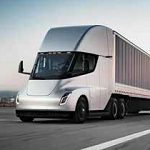
Since I wrote my first book on electric cars in 2008, I have been saying they are the future. Back then I was the outlier but now it is becoming increasingly clear that I got it right.
So now I feel it is time to point to the next step: electric trucks, because there is a myth in the road transport industry that needs to die. This myth is that large trucks – especially ones that are heavily used – will be the last road vehicles to become battery electric.
Based on my research at the Eindhoven University of Technology and the Port of Rotterdam, I conclude that soon the opposite will be true. My prediction is that within five years, electric trucks will become the logical choice for many bulk transporters and that within 10 years they will dominate new sales.
The main source of the myth seems to stem from outdated ideas about battery weight. Let’s take an example: the 40-tonne semitruck that dominates road transport. Exceptions aside, these trucks drive up to 800km a day and to electrify such a truck you would need a one-megawatt hour battery. Only 20 years ago that battery would have been lead-acid and would have weighed 25 tons: more than the entire payload of the truck!
But when I wrote my first book about electric vehicles for the Dutch Ministry of Road Transport 13 years ago, lithium-iron batteries had entered the scene. They already reduced the weight to around 10 tons. And in 2020, a modern car battery including pack weights around 5kg per kilowatt hour or 5 tons per megawatt hour. I expect that within five years that weight will be down to 3.5 tons. And it doesn’t stop there.
In a recent publication we outlined that redesigning a conventional truck from the ground up using an electric drivetrain – something that for example the Tesla Semi has done – would result in 2.5-3 tons of weight reduction. The electric motor is lighter, and you can get rid of the diesel tank and exhaust treatment. Then you place the electric motors between the wheels and lose the differential, driveshaft, and a host of other components.
On battery day Tesla went even further, promising ‘structural batteries’ where the battery partly displaces the steel beams that give a vehicle its rigidity. I estimate this approach could save another ton. And then there are new EU rules that zero emission trucks are allowed to carry two tons more of weight. The end result that within five years, you can expect 40-tonne semis with 800km of range that can carry more cargo than conventional diesel trucks. So battery weight will soon be a problem of the past.
Now let’s talk money. Per kilometre a conventional truck burns around one third of a litre of diesel at one dollar per litre. That’s 30 cents per kilometre in fuel costs. An electric truck engine is two to three times more efficient and uses around 1.25 kWh per kilometre.
Let’s assume a bulk electricity consumer pays eight cents per kilowatt hour. That brings the cost to 10 cents per kilometre in electricity costs. That’s a profit of 20 cents per kilometre.
The battery used to be prohibitively expensive. When I wrote that first book in 2008, that one megawatt hour battery would have cost €1.5 million! But in 2020 the cost of such a battery is down to €150,000 and most experts expect it to get below €100,000 within a few years. Just as important is how long that battery will last. In 2008 you would have had to accept less than a thousand charging cycles which would have meant scrapping the truck before it reached 800,000km or so.
But now 2,000 cycles is the minimum and research by Prof Jeff Dahn and many others indicates that we are heading for batteries that last 10,000 cycles and would basically outlast any truck, even if it drove more than 2 million km. If we assume 1 million km and assume the residual value of the battery is equal to its financing costs, the cost per kilometre of the battery would be 10 cents. That means going electric leaves us with a profit of 10 cents per kilometre!
Of course, there are more things to consider than weight and cost. On the positive side there are things like lower maintenance costs and higher acceleration (which drivers probably like). On the negative side you must arrange for overnight chargers. And you probably need to keep a couple of diesel trucks for really long or multi-day trips. But just imagine: you could dazzle your clients with how sustainable you are, make drivers happy, increase uptime and you could increase profits by 10 cents per kilometre. Can you see why I became convinced electric trucks have a sunny future?
Auke Hoekstra is a researcher at Eindhoven University of Technology, programme director NEON research, and founder Zenmo simulations.